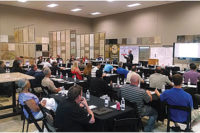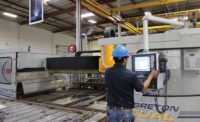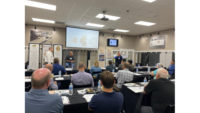A panel of fabricators came together for the MIA/Stone World Dallas Stone Summit for a fabricator forum on March 26, 2015 in Farmers Branch, TX, hosted by M S International, Inc. (MSI). The open discussion covered a variety of topics that local fabricators were eager to talk about, including insurance, upgrading equipment, human resources and more. The panelists included:
• Rob Barnes, Dee Brown, Dallas, TX
• Wesley Cooper, Choice Fabricated Stone, Haltom City, TX
• Jose Lopez, StoneTex, Dallas, TX
• GK Naquin, Stone Interiors, Mobile, AL (moderator)
Naquin: One of the first things I would like to discuss is insurance. Workman’s comp insurance is getting worse and worse as we get into the liability side of it.
Cooper: We carry a lot of insurance — $10 million — as I am sure Rob does. Insurance has never been a question for us. When I started 12 years ago, and we all have to start somewhere, and I know a lot of small shops may not have insurance, but it is very dangerous not to have it obviously. But when I started, I didn’t have it either. You can only afford so much. But insurance is one of the main things, as I have grown; I have had five people killed on my payroll. So I have had a lot of dealings with the insurance companies. It’s not polite, it’s not really nice and it’s not a good thing to go through. It’s a good thing that you have insurance because when that does happen, you can at least know that person’s family is going to be taken care of. It has gotten expensive over the years. The Obama plan has changed a lot of things — maybe not for the smaller shops, but definitely for the bigger shops. I have had guys come up to me asking for help with insurance, but the bottom line is you have to feel comfortable that when you leave and your employees leave to go to a jobsite, that you have the insurance to take care of them.
Barnes: We have to have insurance; we have close to 400 people. We really struggled a few years ago with this because a lot of our competition may or may not, which is a lot less than actually providing insurance for people. But the thing that was really difficult was finding an insurance plan that works for everyone. Five years ago, we had a management policy that covered everyone in the office, and then we had a field policy that was a little bit less. Then with the government regulations with Obamacare, everyone has to be at the same level. So if you tried to take 400 employees and provide insurance for them, you’re all of a sudden talking about millions of dollars a year for insurance. We were already plugging out a million and a quarter for insurance. We had to move to a co-sharing deal, but we had to push the plan down to allow people to buy up. We have an outside company audit us every year so we know what we did is completely by the book, but for the people that were already in the company at the time during the conversion we called it a “fitness incentive.” We put that in their income so they could buy up to the greater level of insurance. You have to have a certain percentage of people adopt into the policy in order to be able to carry it for that big of a class. There are a lot of challenges with it, and I think we are three years into it, and it’s working relatively well. What I was concerned about is the field employee. We provide insurance for the field employee at the co-sharing level, and there are very few of them that will buy up. But I am really shocked by how many of them are paying in to get insurance, because my thought was we have a community hospital and people can just go to that. They will sit there an entire day and wait to get healthcare, but they will get good healthcare. Now with the insurance program at least for themselves, they don’t have to wait an entire day themselves.
Naquin: How about upgrading equipment? I think we had a couple of questions about it. What kind of equipment do you have? What are you planning on getting and what are some questions you have?
Cooper: We are looking into buying a waterjet now. We have an inline machine, a Pro Edge and two bridge saws in my shop.
Lopez: We just recently upgraded with Park to a Fusion and a Titan CNC. I am new to it and have only had it for three months. Learning the system and getting the machine to work — and getting it to work with the hand fabrication in the shop — is new to me, but I am happy with the purchase. We have had digital templating equipment for five years, so it transitioned pretty smoothly.
Barnes: We’ve got five Park machines. We have a late model bridge saw machine that we use for the cubic materials, then we got two Yukon Pro Edge [machines], a two and a three, and a Destiny. We are getting to a place where we need to start talking about it. I don’t see with the kind of work we do, that a waterjet would fit, but I don’t know.
Audience Member: There is so much hand detail we do that we won’t get a machine to do it and a lot of our work is there.
Naquin: I would suggest you look into the new machines because some of the new machinery may be really beneficial to you. The only reason we polish something when we take it off the CNC is because we need time spent milling, and it could easily polish up. Do you follow what I am saying? Do the polishing, it can come right off and we only take it off ogee and bullnose and those intricate pieces because it does it better than by hand. Five years ago, I wouldn’t do it, but the equipment nowadays is so much better. Now, we are looking at labor pools, and maybe in Dallas and Houston you don’t have a problem, but the rest of the country is having a problem finding workers after the recession. It’s not readily available to us like it was 10 years ago. So that’s why we are getting into the machines. Our sawjet cuts three times faster than our bridge saw.
Barnes: Yeah, I think that’s what we would move toward as well.
Lopez: It’s definitely a good machine. Just the material you will get from one slab is great. When I get it off the Fusion and send it to hand fabrication, it’s then done. The Titan will do all the bullnose and ogee and so on, and we are doing by hand quarter bullnose and flat polish, and they just knock it out.
Audience Member: So as opposed to a normal retailer turning inventory four times a year, what’s the acceptable amount for a fabricator to turn through inventory? One problem we run into with sales is we have too much of something or not enough of another.
Cooper: I have some material that hasn’t moved like I thought it would. I am not sure what the forte is for that. For us to keep inventory isn’t exactly feasible.
Lopez: A lot of the time, I ask the supplier what’s popular and what’s moving. I like stocking material because then it’s in my shop. I can invite customers to my place and show them the $29 granite, but it’s all the way in the back so we are going to have to walk by the nice [material] first. They usually ask why are we passing all of this, and I tell them their [stone] is all the way in the back.
Naquin: What are you guys doing to hire new employees?
Barnes: It depends on the type of employees we are trying to hire. Are we talking about management or finishers?
Naquin: Let’s talk about production people.
Lopez: Usually, I ask my guys, do you know anybody? People are hard to come by — good quality people at least.
Barnes: We started our plant operations in the middle of the recession, and we have held steady at five or six guys and had one show from out of nowhere originally from New York. So we haven’t had to actively pursue anyone. If you go to the commercial side of the business, that becomes infinitely more difficult. Now we have got contracts that are requiring driver’s licenses and scanning everybody, and we are one step short of e-verification, which we do background checks to make sure we are hiring workers who can legally work here. The whole immigration issue is something that everyone in this room should know about.
Naquin: Conflict resolution. Rob [Barnes], you want to talk about that one first?
Barnes: We don’t have any conflict. We deal a lot with people who can afford whatever they want — that have expectation levels that exceed industry standards. That’s a fine line of what we can do and what they want. I think the most effective tool we have with them is to spend the time upfront with them before, but then educate them before we go to do something for them. It’s trying to prevent the conflict.
Lopez: I would just say that a lot of times, just listen. Upfront, set expectations — and on the sales side of it. Listen to what they are saying, and give them what they want. At the end of the day, if they still have a problem, as a manager or an owner you show up on site. That has a big role. You show up and give them your two cents of why this happened and how we can fix it. It can help. The main thing is just listen to them.
Naquin: The good part of what we talked about is preventing conflict, but what if we are already in the conflict? The most important thing is we have to listen, and too often we rush to defend what we did. Sometimes it’s very simple to just listen, agree and say, we’re sorry, and it goes away.
Next, how about diversification?
Lopez: I like to have a mixed customer base. It’s never failed where the residential market is booming then we are doing nothing in commercial. It’s good to have that mix, to keep a steady workflow. I actively go out and look for it. We do marketing and go knock on doors of designers, builders and remodelers. The housing went down in 2008, but I was still rocking and rolling because I was remodeling.
The Obama plan has changed a lot of things — maybe not for the smaller shops, but definitely for the bigger shops.





